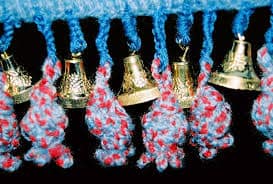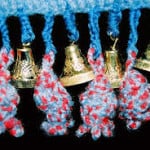We read in the Torah portion, again, of the hem of the robe of the High Priest;
And they made on the bottom hem of the robe pomegranates of blue, purple, and crimson wool, twisted. And they made bells of pure gold, and they placed the bells in the midst of the pomegranates all around on the bottom hem of the robe, in the midst of the pomegranates.A bell and a pomegranate, a bell and a pomegranate, all around on the bottom hem of the robe, to serve as Hashem had commanded Moshe.( Exodus 39:24-26)( Originally described in Exodus 28:33-34),
We need to understand the symbolism behind these two items because as Hashem says” a bell and a pomegranate, all around on the bottom hem of the robe, to serve” Within the symbolism will be revealed the quality of how one is “to serve” Hashem.
The Abarbanel teaches that the ringing bells help the Kohen Gadol be consistently aware of his mission and purpose. In addition it reminded the other Kohanim that he was in the Heichal( the Holy) on their behalf. Most dramatically the sound of the bells served as a gentle knock before he entered into the Holy of Holies. Ramban in agreement with that third approach says:
“so that the sound would be heard in the holy place, and he (the Kohen Gadol) would enter before his Master as if with permission, because one who suddenly comes into the presence of the king, is susceptible to the death penalty according to royal protocols as we have seen concerning Achashveirosh.””
The pomegranates need to be understood as well.
The Torah describes the pomegranate as one of the seven blessed fruits of the land “a land of wheat and barley, vines and figs and pomegranates, a land of oil producing olives and honey,”(Deuteronomy 8:8)
When the spies returned to Moshe and the people with “the good fruits” of the land they also brought pomegranates;
“They came to the Valley of Eshkol and they cut a branch with a cluster of grapes. They carried it on a pole between two peope and they also took some pomegranates and figs.”(Numbers 13:23)
When Solomon described the decorations of the first temple we read;
” And he made the pillars; and two rows round about upon the one net-work, to cover the chapiters that (were) upon the top, with pomegranates; and so he did for the other chapiter. “(I Kings 7:18).
What is it then about the pomegranate that makes them so prominent and expressive?
The Pomegranate is a Biblical sign of blessing. Most fruits are made up of pulp and seeds. The pulp of the fruit is what the fruit uses to sustain and “feed” itself. The seeds of the fruit are what the fruit uses to bring new fruit into the world. The seeds, then, are all about granting further blessing.
The pomegranate is a fruit that is made up mostly of seeds and contains very little pulp. Therefore it symbolizes a fruit with the unselfish desire to grant further blessing in the world without being too concerned with itself and its own needs.
That is why it has the “crown of Royalty” is at its tip.
These then are the ingredients symbolized by the bells and the pomegranates that are seemingly necessary to actually “serve” Hashem.
One must constantly and consistently maintain an awareness of our spiritual purpose .One must also be aware of our brothers and sisters in our spiritual work. Yet one can never lose the humility critical for such spiritual endeavor. Yet all this must come out of an unselfish desire to simply bring blessing into the world.
“A bell and a pomegranate, a bell and a pomegranate, all around on the bottom hem of the robe, to serve as Hashem had commanded Moshe.( Exodus 39:26)
LeRefuat Yehudit bat Golda Yocheved

